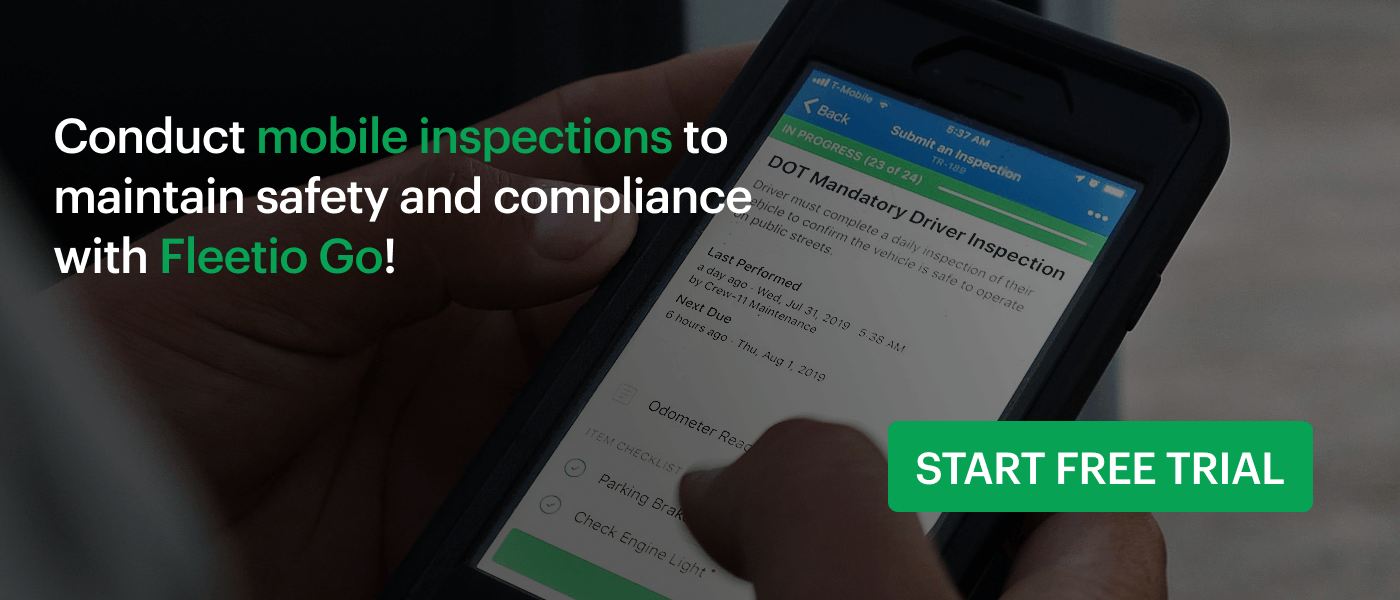We all know the importance of fleet safety management, but without clearly defined policies, fleet safety practices often go neglected. Implementing a fleet safety plan helps avoid accidents and guarantees the safety of your drivers, assets and the public.

1. Set and Communicate Safety Policies With Your Drivers
Fleet safety management is the top priority for any fleet manager, but enforcing safety policies can be a challenge without the proper management system in place. Whether it be a lack of visibility into daily operations or not effectively communicating safety policies with staff, some fleet managers have difficulty avoiding safety issues, often resulting in accidents and costly expenses.
Implementing a fleet safety program begins with setting standards and expectations for your drivers and assets. Start by examining how your drivers use your vehicles and equipment, as well as how you keep track of them. Consider these factors when developing your fleet safety policy:
- Whether drivers take assets home each day or return them to the lot
- What types of tools you have in place for monitoring drivers on the road
- How you keep up with inspection records, licensing and registration renewals
If your drivers take vehicles home each day, you may not see them regularly. Having a way to track vehicle status, health and utilization are imperative to ensure your vehicles are operating safely and drivers stay productive.
Fleet management software maximizes visibility into asset health and usage, enabling you to monitor safety comprehensively. Software provides real-time data regarding your assets and helps you stay connected with your drivers to ensure they’re operating vehicles safely.
Once you’ve created a fleet safety policy, distribute this to current employees, as well as new hires in onboarding packets or signage in the lot. Regularly communicate the importance of safety to your drivers, and consider incentivizing good driving behaviors.
Later, we’ll discuss methods of monitoring drivers and vehicles, but one of the best ways to ensure fleet safety procedures are being followed is to keep safety at the forefront of your driver management plan. Hiring trustworthy drivers and regularly communicating the importance of fleet safety keeps your organization safe and helps you avoid accidents and fines.
It’s especially important for commercial fleets to adhere to safety measures to maintain Department of Transportation (DOT) compliance. These measures can be confirmed easily with the help of fleet vehicle inspection history.
2. Routinely Inspect Vehicles for Safety and DOT Compliance
Vehicle inspections are a great way for drivers to identify potential safety issues and help prevent future breakdowns or accidents. Whether or not your fleet is legally required to complete daily vehicle inspections, this is a good practice to ensure fleet safety practices are being followed.
Paper inspection forms are tedious, and drivers often breeze through them to get back to their daily tasks. This often results in drivers overlooking critical issues.
Paper inspections are also ineffective for many fleet safety plans because they create gaps in communication. Fleet managers often aren’t informed of issues until they receive inspection forms, which can be days or weeks later.
Leveraging a mobile inspection app improves your fleet safety plan by empowering your drivers to complete fast, thorough inspections with clicks, swipes, and even photos to provide further clarity. All inspection results are instantly uploaded into fleet management software, and managers are alerted to issues quickly.
With comprehensive vehicle inspection reports, fleet managers can identify ongoing safety issues that are increasing risks and costing their fleet money. If tire tread is wearing out too quickly on certain vehicles, have a discussion with drivers about harsh braking and speeding. Not only does this mitigate risks, but it also helps you avoid unnecessary expenses that can impact your bottom line.
Improving Preventive Maintenance Practices
Routine vehicle inspections can also improve your preventive maintenance program. Completing inspections with a mobile app allows your drivers to input odometer readings, which can trigger service reminders, helping you get vehicles into the shop on time for regularly scheduled maintenance.
Staying on top of preventive maintenance tasks ensures your vehicles are operating safely and efficiently. Leveraging fleet management software for completing inspections and scheduling preventive maintenance improves your fleet safety plan.
Boosting Sanitization Efforts
In addition to vehicle condition, vehicle sanitization should be stressed to your drivers during the COVID-19 outbreak. Consider including basic cleanliness and sanitization criteria in your vehicle inspections.
Fleet management software allows you to tailor current inspection forms to include sanitization needs, or better yet, use Fleetio’s dedicated COVID-19 Vehicle Disinfection Inspection Form to ensure your drivers and vehicles are safe and healthy!
3. Use Vehicle Assignment History to Monitor Assets
Scheduling and assigning vehicles is standard practice for any fleet manager, but fleets with outdated management systems often don’t keep a record of vehicle assignments. Looking back at vehicle assignment history is a great way to analyze fleet safety and make better decisions for the future.
Using fleet management software for vehicle assignments not only provides a fast, easy way to schedule vehicles, but it also keeps a comprehensive record of assignment history. This record provides insight into vehicle usage, maintenance needs and accident history.
Leveraging this data allows you to make connections regarding any recurring issues with certain drivers or assets. Perhaps a few of your vehicles need brake repairs more frequently than others, and you see that one driver is connected to those vehicles. You may decide to discuss proper braking techniques with him or her to avoid future issues and improve safe driving habits.
4. Leverage Telematics Tools to Maximize Visibility
While you don’t necessarily want to micromanage your drivers, tracking their day-to-day routes is a great way to ensure fleet safety and productivity. You may already be using a GPS or telematics tool, but pairing telematics with fleet management software allows you to access real-time data regarding vehicle status, location and driver behavior.
Fleet managers can receive critical information regarding vehicle health, like diagnostic trouble codes (DTC), as well as stay up-to-date with preventive maintenance needs by automatically syncing odometer readings into your fleet management software.
Telematics tools also provide insight into driver behavior. You can set up alerts to unsafe behaviors like speeding and harsh braking to help you stay informed and rectify any issues. This level of visibility helps cultivate trust with your team, encourages safe driving and provides insight into vehicle maintenance.
Keep your fleet safe on the road with the help of Fleetio! Start your free trial or request a demo today!




